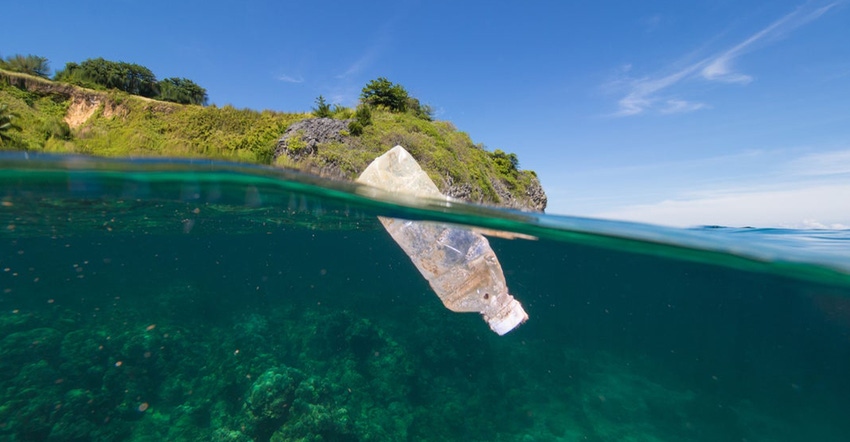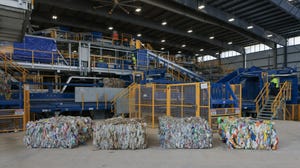rePurpose Global’s Approach to Changing Plastic Waste Management
Several years ago, Peter Wang Hjemdahl and two of his colleagues visited the Deonar landfill in Mumbai, India. On one side, they saw enormous mountains of waste. On the other side was the skyline of Mumbai’s thriving financial district.

Several years ago, Peter Wang Hjemdahl and two of his colleagues visited the Deonar landfill in Mumbai, India. On one side, they saw enormous mountains of waste. On the other side was the skyline of Mumbai’s thriving financial district.
“We were standing there between these two sites, and there-and-then committed to change the way that waste is produced and managed,” says Hjemdahl. Soon after, he and his partners founded rePurpose Global to develop projects around the world that recover plastic trash from nature and offer plastic credits to fund the work.
In this Q&A Hjemdahl discusses how the organization has expanded its focus to come at the global plastic waste crisis in other ways. He explains how brands and other companies participate. And highlights a few compelling projects.
Waste360: Tell us about your plastic recovery projects and how brands get involved.
Hjemdahl: We developed 14 projects across three continents that remove plastic from nature or prevent it from getting there in the first place, which have given more than 10,000 marginalized waste workers a source of income.
We focus on areas that have historically lacked effective waste management systems, around half of which are in coastal areas to address ocean-bound plastic. Each one is designed to work with local resources, in conjunction with local governments and municipalities: some catalyze a door-to-door collection model; others use waste picking and collections from local dump sites.
The finance for these projects comes from brands and individuals (through our plastic credit mechanism). We offer certifications to brands that fund plastic recovery action and go plastic neutral or plastic negative. Brands or individuals may also finance action without certifications, as the environmental and socio-economic benefits that these projects create contribute to wider sustainability or Corporate Social Responsibility goals.
We support the brands by offering footprint measurement tools, plastic reduction consultancy, and can supply recycled plastic. This enables brands to take committed action from all angles.
Waste360: In what parts of the world are you seeing the biggest plastic pollution problem? What’s its impact?
Hjemdahl: Plastic pollution is a global problem. But here’s a breakdown of what is happening in some regions:
Plastic footprints are much higher per person in North America and Europe than in the ‘global South.’ (E.g. per capita plastic use in India: 19.88 kg/year, U.S.: 130.09 kg/year, E.U.:28 54.56 kg/year.
By some measures India and China have the most mismanaged plastic waste (e.g. this table) - an estimated 79 percent of waste in India is mismanaged.
India, China, and Indonesia are also leading contributors to ocean plastic pollution, though studies suggest that the high quantities of mismanaged plastic waste generated by coastal populations in the U.S. likely make it amongst the biggest contributors to the ocean plastic crisis.
Waste360: What’s the story behind your partnership with Burt’s Bees and the projects that came from it?
Hjemdahl: Recently Burt's Bees and rePurpose Global signed a multi-year partnership to finance critical recycling infrastructure that prevents plastic waste from flowing into the ocean. The projects that the partnership support include:
Project Fann Epo - Accra, Ghana with Coliba collects and recycles additional ocean-bound PET plastic (that would not have otherwise been captured) by expanding local collection networks and partnering with buyback centers in the region.
Project Hara Kal - Kerala, India with Green Worms focuses on recovering ocean-bound multilayer (low-value) plastic. The project enables recycling facility upgrades and door-to-door waste collection services for around 2,000 households.
As well as preventing plastic waste from leaking into nature, the initiatives will improve health and safety, working conditions, and wellbeing standards for 350 local waste workers, the majority of whom are female, and create additional income streams from low-value waste materials.
The initiative promises to eliminate more than 1.5 million pounds of plastic waste otherwise bound for the ocean by the end of 2024.
Waste360: What problems are you trying to solve in India and how?
Hjemdahl: We are focusing on Chennai, India now, which does not have the infrastructure to cope with the plastic discarded by its 11 million residents. Dumping and burning of waste, including plastics, is common. Much of it finds its way to the ocean, as evidenced by coating of plastic that is often visible on Marina Beach.
rePurpose Global partnered with Waste Ventures India to develop Project Neela Sapana to stop multilayer plastic (MLP) from reaching the oceans of Chennai. While rePurpose Global funding often helps to scale up existing operations, in this case, it also enabled the setup and initial development of a materials recovery facility.
About 80,8003 pounds of additional MLP and low-value plastic (LVP) have been collected and recovered as part of this project
Waste360: With whom do you partner and how do you vet partners?
Hjemdahl: We work with experienced waste management partners who understand the local waste management context and share our vision for creating social impact in conjunction with environmental impact.
We audit their value chain, ensuring they are working with ethical and authorized stakeholders, conducting due diligence on their operations, checking for social safeguard compliance, doing site visits, and helping them adopt and abide by our Impact Code and Plastic Credit Protocol. We corroborate this via extensive documentation and pilot trials (primarily to assess these parameters, especially traceability of materials).
We continue to work collaboratively with impact partners on our projects, ensuring all plastic credits are verified and traceable, and auditing aspects such as worker wellbeing and safety. We have a social impact fund that is shared with compliant partners that benefits waste workers and their communities.
Thanks to these efforts millions of pounds of plastic waste are removed from natural ecosystems and hundreds of marginalized waste workers have more opportunities and fairer, safer working environments.
Waste360: How does your plastic credits model work?
Hjemdahl: A plastic credit represents one kilogram of plastic waste recovered or recycled that would otherwise end up in the natural environment.
Plastic credits allow individuals and companies to fund plastic collection and recovery through impact projects. rePurpose Global brand partners have become plastic neutral or plastic negative by measuring their footprint, committing to reduction strategies, and balancing their footprints through credits that eliminate at least as much plastic waste from nature as the brand uses in products and packaging.
Plastic credit funding finances crucial infrastructure and facilitates the recovery and recycling of plastic waste. It reduces ocean plastic and empowers waste workers and their communities.
Waste360: What have your clients accomplished with the revenue from plastic credit sales?
Hjemdahl: They have achieved recovery of over 14 million pounds of plastic from nature each year, cleaner communities, less polluted ecosystems, and improved livelihoods for waste workers. Brands also help raise greater awareness of the plastic waste crisis and advocate for solutions.
Waste360: Plastic credits are pretty new. What growth have you started to see and what does the near-term future look like?
Hjemdahl: The first plastic credits were issued in 2019. Since then, our coalition has grown to over 250 brands across 26 countries. Just a few of our brand partners are Grove Collaborative, AB InBev, Credit Suisse, Clorox, Google, and Colgate. We expect our projects to generate over 9 million credits this year, financed by brands. And we are on track to issue over four times as many credits this year as in 2021.
Waste360: How can a buyer of credits know they are purchasing a credible product?
Hjemdahl: I can only speak for our credits. We have strict criteria as to how our credits are generated, verified, and tracked (see our Plastic Credit Protocol), and as to which impact partners we work with.
Partners and clients can also access our Impact Code and Plastic Neutral Standard. We have made these publicly available to transparently share best practice and drive standards.
These frameworks document some of our fundamental rules, such as our 'no landfill or incineration' policy, rights and equalities policies, socio-economic impact, environmental protocols, stance against child labor, and more.
We can facilitate third-party audits for our impact projects upon demand and have an open-door policy where anybody can visit any of our projects across the world.
Some of our projects recently received the Ocean-Bound Plastic certification from Zero Plastic Oceans and Control Union. We also work closely with Verra and were a co-developer of Verra's Plastic Waste Reduction Standard.
Waste360: You say nearly half of consumers are willing to pay more for plastic-neutral products. Where did you get that figure and what else have you found?
Hjemdahl: We conducted a survey in 2020 on a sample of 203 individuals, representative of the U.S. population. Below is a breakdown of the findings:
44 percent of customers strongly agreed or agreed with the statement “I would be willing to pay a higher price for a plastic neutral-certified product.”
This willingness to pay has been backed up independently by one of our partner brands - Mananalu. They conducted additional research at Appalachian State University in North Carolina, which indicated that consumers were willing to pay:
$1.36 for a plastic 16-oz water bottle
$0.42 more for an aluminum bottle of the same size
$0.24 more for “drink one remove one,” even if the bottle wasn’t aluminum
Other research shows that sustainably marketed products are growing 5.6 times faster than conventionally packaged products.
Waste360: What’s the Plastic Reality Project and what’s its aim?
Hjemdahl: The Plastic Reality Project is a sustainability initiative dedicated to upskilling and arming corporate leaders and environmental practitioners with knowledge and experiences to help improve the effectiveness of plastic reduction and recovery efforts.
According to independent research by Gartner, 90 percent of sustainable packaging commitments set by global enterprises are not on track to be met by 2025, while World Wildlife Fund predicts that global plastic production will more than double by the end of the decade. To help bridge the gap between ambition and action, the Plastic Reality Project will facilitate initiatives such as educational expeditions, corporate training programs, and peer mentoring networks.
Launched with support from Sustainable Ocean Alliance and the GreenBiz Group, the inaugural project begins September 11, 2022 as a week-long expedition to two states across India. Over 20 leaders are expected to participate on behalf of organizations including The World Economic Forum, Target, Emerson Collective, Riverside Natural Foods, and Coca-Cola.
NOTE: This Q&A was edited for length.
About the Author(s)
You May Also Like




